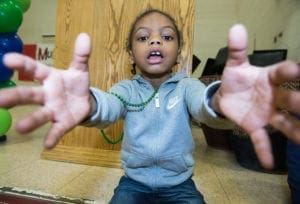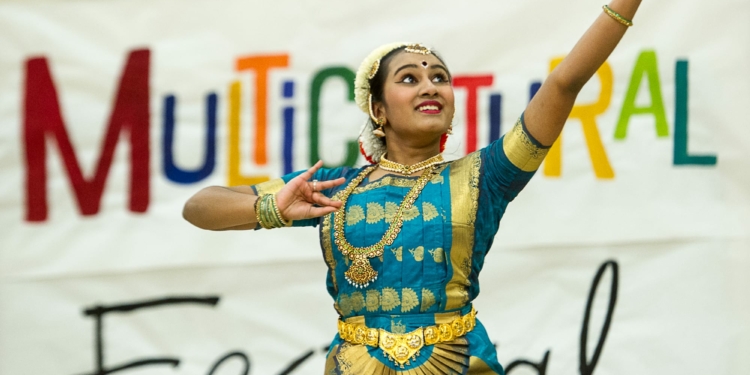COLONIE — Dr. Shyam Mahajam was smiling proudly as he watched his granddaughter perform a traditional Indian dance during the Multicultural Festival at Colonie High School. And he was no different than grandfathers from Germany, China, Africa, Ireland and Thailand.
Despite sometimes stark variations in language, clothing, religion, skin color and food, humans are really not all that different, he said during the Friday, April 6 event at Colonie High School. Those differences should be explored and celebrated to peel back the external layers so people can see the underlying, fundamental similarities.
To view a slideshow of the event click here.
“The main aim of the human is to stay in peace and the peace will never come if we do not accept there are differences in the people but the people are basically the same,” he said. “There are different ways to reach the ultimate goal in life, and the ultimate goal in life is having peace here [pointing to his temple] and that will not happen, cannot happen, if you don’t respect other people.”
 “We are sharing our food,” he added. “Sharing of food is one of the most important things humans can do together.”
“We are sharing our food,” he added. “Sharing of food is one of the most important things humans can do together.”
Dozens of different nationalities with ties to South Colonie shared their cultures with each other and the community at large at the annual festival, which has gotten more popular each year. The different booths featured authentic food and art from native countries, dance routines and music was performed and there was a fashion show featuring authentic garb from around the world. Each nationality had a general information board for anyone willing to learn and there were people at the booths to answer questions.
The inherent message of the event is important today, when immigration and “the wall” are constantly making news and is working to divide the country, said April Mlambi, an English as a new language teacher at Sand Creek Middle School.
“There are Mexican and Middle Eastern students who feel they need to defend themselves and their culture so this is a way to keep everything positive and to connect in ways we connect most easily which is through music and food and culture,” she said. “We tend to become compartmentalized, and we retreat to our own communities sometimes. And it’s great to be in a venue like this when you have an opportunity to see something a little different, to have a conversation over food or stand next to someone and watch a performance. I think there is that undeniable connection of humanity that happens in this kind of environment.”
Mlambi started the Multicultural Festival with a potluck dinner for her English as a second language students and their families in the Sand Creek faculty room. As interest grew, they moved to the cafeteria and then last year to the Sand Creek gym and this year to the larger high school gym.
There were white, black, brown and yellow skin colors. There were flowing, ornate robes and blue jeans. There were turbans and baseball caps. And there was pasta and Filipino shaved ice sundaes.
“It’s a big world and there are many people of different cultures and we all live in America, it is the land of immigrants, so what better venue than this to be exposed to all the different religions and cultures of the world,” said Dr. Paul Uppal, of the Sikh Temple in Niskayuna who lives in Colonie. “Despite all these differences. People are the same and the more we mix together like this the more we realize it.”
“It’s important to hold onto your own culture and it’s important to understand other cultures as well because we want them to understand ours.”
 The Sikh information table was one of the busier as volunteers from the Niskayuna and Rensselaer temples were tying turbans, in traditional Sikh fashion, on the heads of the curious who happened by.
The Sikh information table was one of the busier as volunteers from the Niskayuna and Rensselaer temples were tying turbans, in traditional Sikh fashion, on the heads of the curious who happened by.
Jorawar Singh Mohal, who practices Sikhism, is now a seventh grader at Sand Creek and is getting along rather well. When he first came to South Colonie two years ago, though, he was bullied and some made fun of his clothing and his turban, which all Sikh men wear. Last year he spent hours making information boards to help explain his religion to his fellow classmates.
“People come over and they talk and they want to learn about this, and it makes me feel good about myself,” he said. “This is an opportunity to tell people about where I come from and what my culture is about.”
Across the gym from the Sikh table Anusa Masambo, also known as Chief Salanje, dressed in a brightly colored poncho and native headdress, was telling people about his home of Chowe Manogochi, a village in the African country of Malawi.
“Malawi is a very welcoming country and no matter where you come from you are welcome as one of our own so sharing this is our pleasure,” he said, adding one of the biggest adjustments he had to make when coming to America six years ago was how some people respond, or don’t respond, to a simple greeting. “In Malawian culture it is the first thing we do and it doesn’t matter what race or what religion or what age. A greeting is the basic, first thing we do.”
He and his wife were serving authentic Malawian food of vegetables and fish and were asking people to eat it with their hands like they do in his home country, where they generally take their meals while sitting on the floor.
At the Thailand table Wichuda Pollak, who married an American, said the event helps mixed race children appreciate her side of their linage.
“This is new to me too, but it’s important to me for my children to know where I came from and where they come from,” she said. “We have so many different cultures in South Colonie that I think it’s great we can all come together and share them with each other. We are all human. Even though we have different cultures, we are all living by the same principals.”



